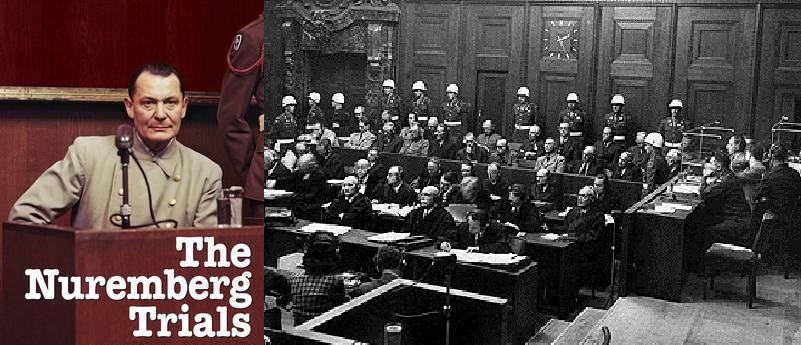Welcome to About Nuremberg, below you will find a brief informative introduction to our topic of study and the controversies behind it.
At
the end of World War II the Nuremberg trials began in an attempt to reanimate
the horrors of Nazi war crimes; this time in a court room for the whole world
to observe. The Jewish people, having been targeted by Hitler’s Nazi Germany, were
victims of torture, murder, rape, and racial alienation. Under the London Charter
the International Military Tribunal was formed and composed of eight judges,
two from each main Allied nation, whose main purpose was to ensure that those who
committed these crimes were held accountable under an international justice
system. The Nuremberg trials were unprecedented, and therefore were very controversial;
the issue of following orders and whether the sentences laid were truly just, are
at the centre of controversy.
The Nuremberg Trials were a series of
court sessions, held from 1945-1949, where many Nazi officials and Japanese
officials were put on trial on the grounds of war crimes. However the most eminent
cases of The Nuremberg Trials were those concerning the fate of Nazi Germany’s
most senior officials. These officials were accused of up to four various counts
of war crimes, and their sentences varied from acquittal to death by hanging. These
officials included:
The Accused
Martin
Bormann: Secretary to Hitler, Head of the Nazi Party Chancellery
Karl
Doenitz: Commander-in-Chief of the German Navy
Hans Frank:
Governor-General of occupied Poland
Wilhelm
Frick: Minister of the Interior
Hans
Fritzsche: Head of the Wireless News Service (radio produced by the Reich)
Walther
Funk: Minister of Economics
Hermann
Goering: Second-in-command to Hitler, Luftwaffe (Air Force) Chief, President of
Reichstag
Rudolf Hess:
Deputy to Hitler, Nazi Party Leader
Alfred Jodl:
Chief of Operations for the German High Command (Army)
Ernst
Kaltenbrunner: Chief of Security Police, Chief of RSHA (an organization
containing, among other things, the Austrian branches of the SS and the
Gestapo)
Wilhelm
Keitel: Chief of Staff of the German High Command
Erich
Raeder: Commander-in-Chief of the German Navy (before Doenitz)
Alfred
Rosenberg: Minister of the Eastern Occupied Territories, Chief Nazi Philosopher
Fritz
Sauckel: Head of Slave Labor Recruitment
Hjalmar
Schacht: Minister of Economics (pre-war), President of Reichsbank
Arthur Seyss-Inquart:
Chancellor of Austria, Reich Commissioner of the Netherlands
Albert
Speer: Minister of Armaments and Munitions, Hitler's architect and friend
Julius
Streicher: Editor of Der Sturmer (anti-Semitic publication)
Konstantin
von Neurath: Minister of Foreign Affairs, Reich Protector for Bohemia and
Moravia
Franz von
Papen: Chancellor of Reich before Hitler, Vice Chancellor under Hitler,
Ambassador to Turkey
Joachim von
Ribbentrop: Foreign Minister, Ambassador to Great Britain
Baldur von
Schirach: Head of the Hitler Youth
The Nuremberg trials caused
much controversy because some believed the trials were biased. In fact the defence
had made appeals, which were later denied, on the terms that the Judges had
presented a biased decision in the verdicts. Furthermore there had been an
issue with the relevance of “superior orders” in these trials. The main argument
for the defence was that the accused officials all answered to Hitler as a
superior, and that the crimes committed against humanity and the Jewish people
was not out of their best interests but of Adolf Hitler’s. Through an analysis
of source documents we now know that the Nuremberg Trials were fair, and that
the rights of the accused were safeguarded. The Nazis accused, were all given
the right to counsel, the right to representation, and the right to a fair
trial under the regulation and laws of the IMT.
Gregory Kim

